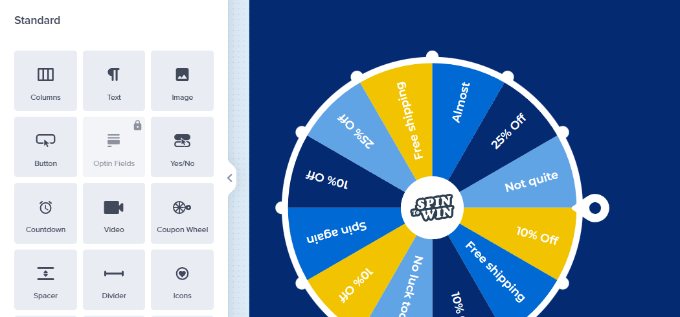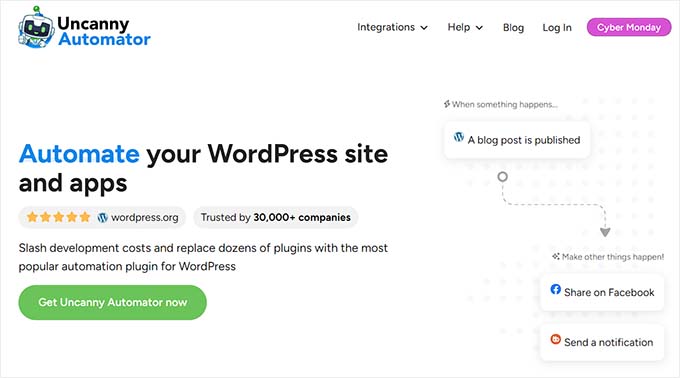A small improvement to make your site visitors’ experience just a bit smoother.
WORDPRESS
13 Best Fun WordPress Plugins You’re Missing Out On

Are you looking to find the best fun WordPress plugins for your website?
Since there are thousands of plugins available on the market, it can be difficult to pick the ones that will actually add a fun and interactive element to your site while boosting conversions.
To make this easier for you, we tested some of the most popular plugins on the internet and examined factors such as ease of use, features, customization, and pricing.
In this article, we will share our list of the best fun WordPress plugins that you may be missing out on.

If you are in a hurry, then you can take a look at our top picks to quickly choose the best fun WordPress plugin for you:
How Do We Test And Review Fun WordPress Plugins?
We installed and tested every plugin from this list on our websites to find their features, pros, and, cons, and provide you with the best recommendations.
While we were doing that, we paid special attention to the following criteria to pick the best fun WordPress plugins:
- Popular plugins: We tested the most popular and best WordPress plugins on the market to see if they can add a fun element to your site. We analyzed those plugins based on ease of use, features, pricing, and customization options.
- Different use cases: There are various ways to make your site enjoyable for users. That is why we reviewed plugins for all kinds of use cases like spin the wheels, giveaways, quizzes, interactive elements, ranking systems, and more.
- Plugins tested by us: We included plugins that we have used on our own websites to boost engagement and add fun elements.
Why Trust WPBeginner?
At WPBeginner, we are a dedicated team of people with over 16 years of experience in WordPress, design, and online marketing.
Our WordPress experts extensively review each plugin or tool that is featured here and thoroughly test them on real websites. To learn more, you can see our complete editorial process.
Having said that, here is our list of the best fun WordPress plugins that you are missing out on.
1. OptinMonster (Spin to Win Optins)


OptinMonster is the best lead generation and conversion optimization tool on the market that lets you create amazing spin-to-win optins. They can add a gamification effect to your website and make it more interactive and fun for your visitors.
Once you have added the wheel, users can enter their email addresses and spin the wheel to win different prizes, such as discount codes and coupons. This can convert website visitors into subscribers and customers.


The software has a drag-and-drop builder and premade templates that make it super easy to build spin-the-wheel campaigns. You can also add dynamic content, countdown timers, CTA, images, and email fields to capture leads.
For detailed instructions, see our tutorial on how to add spin to win optins in WordPress and WooCommerce.


Pros
- You can also create optin forms, popups, floating bars, slide-ins, and banners with OptinMonster.
- The tool can integrate with popular email marketing services and CRM (Customer Relationship Management) software.
- It comes with triggers and display rules like exit intent technology. Upon testing the plugin, we realized that this could help build FOMO (fear of missing out) by showing limited-time offers or exclusive content before a visitor leaves the page.
- The software also offers A/B testing, analytics, and geolocation targeting.
Cons
Why we recommend OptinMonster: It is the best spin a wheel coupon plugin that makes it super easy to add gamification elements to your website. Plus, OptinMonster comes with premade templates and a drag-and-drop builder and also lets you create popups and banners, making it a super fun option.
For more information, you can see our OptinMonster review.
2. RafflePress (Giveaways and Contests)


RafflePress is the best WordPress giveaway plugin on the market. It allows you to host all kinds of contests and giveaways to add a fun element to your site while generating leads.
It comes with a drag-and-drop builder and premade templates. Plus, it allows you to add multiple methods for giveaway entry, including subscribing to your email list, following you on social media, and visiting specific pages.


We have actually used the plugin on WPBeginner to run a viral giveaway and found it super easy to use.
For more information, you can see our tutorial on how to run a giveaway/contest in WordPress with RafflePress.
Pros
- RafflePress offers complete fraud protection from spam entries.
- It can integrate with email marketing services, form plugins, and CRMs. This can help you add different entry methods for the contest.
- It comes with a built-in integration with SeedProd. This means that you can add your giveaways on attractive landing pages.
- Some of its other features include success tracking, retargeting, social logins, email verification, and a prize gallery.
Cons
- The plugin has a free plan, but you will need the pro version to unlock more templates and entry methods.
Why we recommend RafflePress: It is a super fun plugin that adds a gamification effect to your website and helps you build your email list or social media followers at the same time. You can bring back more customers and attract new ones by offering freebies or discounts to giveaway winners.
For more details, you may also like to see our RafflePress review.
3. Uncanny Automator (Fun Automated Workflows)


Uncanny Automator is the best automation plugin on the market that acts like Zapier for WordPress. You can use it to create fun, automated workflows for your website.
For example, you might use the plugin to connect your blog with Twitter. Now, every time you publish a new post, it will automatically be tweeted on your handle. This can help boost followers and attract new users.
Similarly, you can send birthday emails with special offers, share user-generated content, or send cart abandonment reminders. To learn more, you can see our tutorial on how to create automated workflows in WordPress with Uncanny Automator.
Pros
- It is a great Zapier alternative that can integrate with 150+ tools, including form builders, Instagram, LinkedIn, Facebook, BuddyPress, and WooCommerce.
- The plugin is easy to use and comes with unlimited recipes and triggers.
- It also has advanced features like delays, scheduling, and user creation.
- During our testing, we discovered that you can connect multiple WordPress sites with it.
Cons
- The plugin has a free plan, but it comes with limited triggers and actions.
Why we recommend Uncanny Automator: It is a super fun plugin that you can experiment with to build different workflows and save time on your website. For instance, you could integrate it with a gamification plugin to reward users for specific actions.
For more details, you may also like to see our Uncanny Automator review.
4. TrustPulse (Build FOMO and Social Proof)


TrustPulse is the best WordPress social proof plugin that lets you build FOMO on your website to boost conversions.
It lets you display a live sale notification in your eCommerce store to real-time visitors, which can motivate them to make a purchase as well.
Other than recent purchases, it can also display bubble notifications for form submissions or free trial sign-ups to encourage users to join your email list.
For more information, you can see our tutorial on how to use FOMO on your WordPress site to increase conversions.
Pros
- The plugin allows real-time event tracking on your website.
- When reviewing the plugin, we noticed that it allows you to customize your notifications to match your brand identity. You can adjust colors, fonts, and animations, and even add custom messages.
- TrustPulse also offers smart targeting, A/B testing, analytics, and exit intent notifications.
Cons
- The plugin does not have a free plan.
- Its analytics feature is basic compared to other tools.
Why we recommend TrustPulse: It is one of the best fun WordPress plugins that can boost sales for your small business by showing social proof to users. This can cause FOMO among visitors, which can lead to more conversions for your online store.
See our TrustPulse review for more information.
5. Chrismasify (Christmas Effects)


Chrismasify is a free WordPress plugin that you can use during the Christmas season to add fun elements to your WordPress blog.
You can add jingle music, snowflakes, and a flying Santa on your website to create holiday spirit. This can motivate visitors to explore your site and even make a purchase if you have an online store.
For more ideas, you can see our tutorial on ways to spread the holiday spirit with your WordPress site.
Pros
- The plugin is completely free and has a user-friendly interface.
- It lets you control the speed of the snowflakes and adds Christmas decorations to images as well.
- We liked that you can also change the heading’s font on your website to add holiday cheer.
- The plugin lets you configure the activation and deactivation dates for the Christmas effects.
Cons
- Chrismasify is just used for adding interactive elements. It cannot help you build an email list or boost conversions.
- The plugin does not have great customer support.
Why we recommend Christmasify: If you are planning a holiday sale, then you can use Christmasify to add some fun elements to your online store. This can spread the holiday spirit on your site and encourage users to make a purchase.
6. Thrive Quiz Builder (Engaging Quizzes)


Thrive Quiz Builder is the best WordPress quiz plugin on the market that lets you create all kinds of fun and interactive quizzes without using any code.
It comes with an intuitive drag-and-drop builder and premade templates that you can use to add right/wrong, number, percentage, or personality quizzes.
For example, if you have a travel business, then you could add a quiz that suggests the next destination users should visit based on their hobbies. This can boost engagement and lead to more business for you.
The plugin also offers gamified elements like progress bars, customizable results pages, and social sharing options to further boost user engagement.
For more information, see our beginner’s guide on how to easily create a quiz in WordPress.
Pros
- We particularly appreciated the branching questions feature. If you use this option, then the next question displayed to the users in a quiz will depend on their previous answer.
- Thrive Quiz Builder comes with different question formats like multiple choice, true or false, open-ended, personality, and matching questions.
- Based on quiz results, you can automatically tag users with specific categories or segments within your email marketing platform.
- It is a part of Thrive Themes and can integrate with other plugins like Thrive Architect, Thrive Leads, and Thrive Optimize.
Cons
- Thrive Quiz Builder has no free plan.
- It has a lot of features, which can be confusing for beginners.
Why we recommend Thrive Quiz Builder: Quizzes are a great way to boost engagement and attract more visitors. You can use this plugin to build amazing quizzes that suit your niche.
For details, see our Thrive Quiz Builder review.


Football Pool is another fun WordPress plugin that adds a sports pool to your website. Here, users can predict the outcomes of matches and earn extra points.
You can select different leagues and tournaments that you want to add to your sports pool and add multiple prediction types like winner, score, or first goalscorer.
Football Pool also allows you to add registration forms so that users can log in to participate in the pool. Additionally, it displays a leaderboard showing the top participants based on points and users can view their own points on their profiles.
Pros
- The plugin is completely free.
- It comes with automatic points calculation, bonus questions, social media sharing, and email notifications.
- When we reviewed the tool, we found out that you can set deadlines for users to submit their predictions.
Cons
- It offers limited customization options.
- The plugin does not have great customer support.
Why we recommend Football Pool: If you have a WordPress blog related to sports, then this plugin can be a great way to add some fun elements to your site. It can encourage more users to log in regularly to submit their predictions and earn points, ultimately increasing traffic on your blog.
8. WPForms (Polls and Surveys)


WPForms is the best WordPress contact form plugin on the market that you can use to add fun polls and surveys to your website.
It comes with a drag-and-drop builder, 1700+ premade templates, and complete spam protection, enabling you to build any kind of secure form you like.
You can easily add an interactive poll that can boost engagement and also help you gather feedback from your audience on different topics.
For more information, see our tutorial on how to create an interactive poll in WordPress.
Pros
- If you have a fitness blog, then you can add a fitness tracker or BMI calculator to your site.
- You can also connect your forms with any popular gateways like PayPal or Stripe.
- Upon testing, we discovered that the plugin lets you add progress bars, star ratings, and file upload fields to your forms.
Cons
- WPForms has a free plan, but some of the features are only available with the paid plugin.
Why we recommend WPForms: If you want to add polls and surveys to make your site more enjoyable for users, then WPForms is the best choice for you.
You can see our WPForms review for more information.
9. Smash Balloon (Embed Social Media Feeds)


Smash Balloon offers a suite of different plugins that allow you to embed social media feeds into your website, including Instagram, Facebook, YouTube, TikTok, and Twitter.
These feeds can show a more fun side of your business to your website visitors, which can boost user engagement.
Adding a social wall feed is a good idea because it can motivate visitors to check your social media profiles, leading to more followers.
Smash Balloon comes with an intuitive feed editor, premade layouts, and multiple customization options for your feeds. If you have a YouTube channel, then you can even embed your YouTube live streams to increase site traffic.
Pros
- All the Smash Balloon plugins are completely mobile responsive.
- Smash Balloon lets you embed Facebook, YouTube, Twitter, or Instagram feeds without using any code.
- The plugins enable you to filter your feeds to display specific content and control what appears on your website.
Cons
- All the Smash Balloon plugins have free plans with limited features. To access advanced options, you will need the premium versions.
Why we recommend Smash Balloon: You can use any of the Smash Balloon plugins to showcase your social media feeds and display social proof on your website.
For more information, you can see our Smash Balloon review.


Thrive Comments is the best WordPress comments plugin that can gamify your comments section to boost engagement.
It comes with a built-in voting and badge feature that allows you to award points and badges to users based on different criteria. For instance, you can give a silver badge to users if they have 5 comments on your site and a gold one if they have 10.
Additionally, you can use the plugin to add a like/dislike functionality. This will discourage users from leaving spam comments.
For details, see our beginner’s guide on how to add a simple user ranking system for WordPress comments.
Pros
- It has a dedicated moderation area, provides analytics, and shows custom messages to users upon leaving their first comment. This can improve the user experience.
- The plugin allows users to subscribe to comments in WordPress.
- When we were testing it, we found out that Thrive Comments also enables users to leave comments using their Facebook or Google accounts.
- The plugin lets you feature interesting comments at the top of the section.
- It is a part of Thrive Themes and can integrate with other plugins from the suite.
Cons
- Thrive Comments does not offer a free plan.
- Its analytics and reporting feature is basic compared to some other tools.
Why we recommend Thrive Comments: If you want to use a fun WordPress plugin to add gamification to your comments section, then this is the perfect solution for you.
Thrive Comments allows you to award badges, add like/dislike icons, feature interesting comments at the top, and even allow users to subscribe to different comments.
11. myCred (Create a Points System)


myCred is a WordPress points management plugin that can add a fun loyalty program or gamified system to your website.
You can use different hooks provided by the plugin to award points to users. For example, you can award points upon user registration, leaving a comment, submitting a guest post, making a purchase, and more. Then, you can reward your active users with coupons and discounts.
This can create brand loyalty among customers and increase conversions if you have a WooCommerce store.
To learn more, you can see our tutorial on how to add a points system in WordPress.
Pros
- It lets you add multiple point types and award points automatically when the user performs the required action.
- The plugin allows users to check their points balance and history.
- You can award discount coupons, freebies, and exclusive offers to users upon achieving certain points. We particularly liked the badge feature that you can use to award badges and appreciate users when they reach different levels.
- myCred lets you create a leaderboard to display the top point achievers.
Cons
- Its free plan has limited features.
- Using a lot of the addons offered by the plugin can sometimes hurt your site speed.
- Setting up the plugin can be complex because it has a lot of features.
Why we recommend myCred: If you want to add a points system to your WordPress website, then this is the best fun plugin for you. It will help build loyalty and ultimately generate leads.
12. Chartify (WordPress Charts)


Chartify is another fun WordPress plugin. It helps you build all kinds of charts for your website, including bar charts, pie charts, column charts, donut charts, histograms, and so much more.
The plugin is completely free and allows you to modify the visual effects for your charts like color, font, labels, and titles.
Plus, it shows a live preview so you can see all the changes you made in real time.
Pros
- It allows you to enter data directly within the plugin.
- Chartify lets you import CSV files and connect with Google Sheets.
- You can easily integrate any chart using the block in the Gutenberg block editor.
Cons
- Adding a lot of charts can increase your page load time.
- It does not come with any advanced features to build charts.
Why we recommend Chartify: If you want to add a fun element to your blog posts, then you can use Chartify. It will help you build all kinds of visually appealing charts that can make your articles a more interesting read for users.
13. Confetti (Confetti Effect)


Confetti is a super fun WordPress plugin that adds a confetti effect to your website using a block.
It has a free plan, is easy to use, and allows you to customize the color and size of the confetti as well.
Additionally, upon review, we discovered that it offers different kinds of confetti effects, including fireworks, school pride, falling, realistic cannon, and more.
Pros
- The plugin can integrate with WooCommerce, WPForms, MemberPress, LearnDash, Formidable Forms, and more.
- You can configure the plugin to show the confetti effect when you scroll to a specific point on a page.
- It also provides a preview of all the effects before you add them to your site.
Cons
- The plugin is basic and does not offer any advanced features.
- You can only integrate the plugin with other tools once you upgrade to the pro version.
Why we recommend Confetti: If you are announcing a winner for a competition or just want to add a visually appealing effect to your blog, then Confetti can be a great choice.
Which Is the Best Fun WordPress Plugin?
In our expert opinion, OptinMonster is the best fun WordPress plugin because it lets you add a spin-the-wheel popup on your page. This makes your website more engaging and can also help you collect leads.
However, if you want to host a competition or giveaway, then RafflePress should be your go-to option. On the other hand, if you want to use FOMO to boost conversions, then you can choose TrustPulse instead.
Similarly, if you want to add personality quizzes or polls, then we recommend Thrive Quiz Builder and WPForms.
Frequently Asked Questions About Fun WordPress Plugins
Here is a list of some questions that are frequently asked by our readers:
What is the most popular WordPress plugin?
WPForms is one of the most popular WordPress plugins, with over 6 million active installations.
It is the best form builder on the market that comes with a drag and drop builder, 1700+ premade templates, and complete spam protection. You can use it to create any kind of form you like, including contact forms, registration forms, login forms, online order forms, and more.
Will these fun WordPress plugins slow down my website?
Using a poorly-coded plugin can slow down your website. However, we have thoroughly tested all the plugins on our list to make sure that they are updated regularly and optimized for speed.
Still, you must keep in mind that using a lot of plugins at the same time can slow down your website. We recommend choosing only 3 to 4 fun plugins to boost engagement.
Is it okay to use multiple plugins on my website?
You can add a few well-chosen plugins to make your site more enjoyable. However, you must keep in mind that too many plugins can clutter your site and overwhelm visitors.
That is why we recommend choosing plugins that complement each other and do not have overlapping functionalities.
For more details, you can see our tutorial on how many WordPress plugins you should install and how many are too many.
Related Guides to Fun WordPress Plugins
If you liked this article, then please subscribe to our YouTube Channel for WordPress video tutorials. You can also find us on Twitter and Facebook.
WORDPRESS
How to Add Smooth Scrolling Anchor Links to Your Website – WordPress.com News

An “anchor” link is a link that takes readers to a specific spot on the same page (rather than taking them to a new page altogether). It’s like a shortcut. In most cases, clicking that link brings readers to the desired place with an abrupt jump. In today’s Build and Beyond video, Jamie Marsland shows you how to make that transition a smooth scroll instead of a jump, making for a more pleasant reading and browsing experience.
Ready to get going? Start your free trial today:
Join 110.8M other subscribers
WORDPRESS
Tailored Plugin Management for Your Website – WordPress.com News

Scheduled plugin updates are here (at no extra cost).
In recent weeks, we’ve announced a few new tools for developers that make WordPress.com the best place to build any WordPress site: Studio local dev app, GitHub Deployments, improved navigation and user interface, and more.
Today, we’re continuing the streak with our latest feature: scheduled updates for plugins.
Say goodbye to the hassle of manual updates because streamlined plugin management tools are here and designed to elevate your site’s reliability and performance.
Plugin updates on your terms
With our newly launched scheduled updates, you can set the exact time and day for updates to occur, ensuring they happen when it’s most convenient for you and your clients. Best of all, this feature is free to use on our Creator and Entrepreneur plans. We won’t name names, but update scheduling is often a paid add-on at other hosts.
At the selected time, our system automatically checks for available updates for the plugins included in your schedule. If updates are available, the system initiates the process, starting with a health check to ensure your site’s stability. Each plugin is updated individually, with another health check performed after each update to verify everything is functioning as expected.
Should a health check fail, our system will automatically roll back the update and restore the previous version. In the rare event that a rollback is unsuccessful, our dedicated Happiness Engineers are standing by to manually restore your site and assist you further.
To stay on top of what’s running in the background, you can opt to receive an email notification after each scheduled update summarizing the plugins that were updated as well as any update or health check failures. (These emails aren’t sent if no updates are found.) Additionally, you can easily monitor the results of the most recent schedule run on the Scheduled Updates screen under Plugins → Scheduled Updates.
Why does it matter?
Let’s say you run an ecommerce store on WordPress.com. Your site relies on key plugins for inventory management and payment processing. In the past, updating plugins during business hours led to downtime and lost sales. With scheduled updates, you can now plan updates for off-peak hours, when you’re at home restfully sleeping, ensuring essential functionality remains intact during busy periods while keeping your site secure and up-to-date. Scheduling updates for your payment processing plugin to occur every Sunday at 2:00 AM will greatly minimize shoppers’ disruptions.
Why our scheduled updates are better
- No additional charge: Scheduled updates are included with our Creator and Entrepreneur plans at no extra cost.
- Multiple schedules: Create separate schedules for different plugins, offering greater flexibility and control compared to competitors.
- Specific scheduling: Schedule updates at a specific hour for precise timing control.
- Customizable health check paths: Specify custom paths for health checks and testing on a per-site basis, providing unparalleled flexibility.
- Granular schedule pausing: Pause individual update schedules for targeted control, a feature not offered by other hosts.
- Detailed logging: Comprehensive logging of update activities, including successes, failures, and rollbacks, ensures transparency and accountability.
- Faster setup: Our setup process is lightning-fast, with no need for extra information collection or onboarding.
How to get started
Creating a schedule for plugin updates is fast and convenient:
- Install your desired plugins on a Creator or Entrepreneur site. (Plugins included in our plan offerings or purchased through the WordPress.com Marketplace are kept up-to-date by WordPress.com and do not need to be scheduled.)
- Navigate to the Updates Manager: Plugins → Scheduled Updates. (Click here to visit the multisite update manager.)
- Click “Add new schedule” and select your desired update frequency.
- Choose the plugins you’d like to include in the schedule.
- Click “Create” to activate your schedule.
For more details, visit our Update a Plugin or Theme support page.
Take control of your plugin updates
Click here to get started with a free hosting trial and experience the peace of mind that comes with scheduled updates.
Stay tuned for more enhancements coming soon, including the ability to create update schedules for multiple sites at once and many more features.
Join 110.8M other subscribers
WORDPRESS
3 Ways for WordPress Devs, Agencies, and Freelancers to Prepare for 2025 – WordPress.com News
2025 is closer than you think.
It may be hard to believe, but we’re nearly halfway through 2024, which means it’s not too early to start thinking ahead to next year. In this Build and Beyond video, Jamie Marsland speaks with Nick Diego, a Developer Relations Advocate and Core Contributor at WordPress.org, about ensuring you’re prepared for the exciting developments in store for WordPress in 2025.
Ready to get going? Click below to embark on your free trial today:
Join 110.8M other subscribers
-

 MARKETING6 days ago
MARKETING6 days ago3 Contextual Link-Building Strategies That Actually Work
-

 MARKETING7 days ago
MARKETING7 days agoGoogle’s Surgical Strike on Reputation Abuse
-

 PPC5 days ago
PPC5 days agoGoogle Ads Releases New Search Partner Insights & Controls Following Advertiser Concerns
-

 PPC6 days ago
PPC6 days ago5 Campaign Red Flags And Why They Matter
-

 SEO5 days ago
SEO5 days agoChatbots And AI Search Engines Converge: Key Strategies For SEO
-

 SEO5 days ago
SEO5 days ago14 Ways to Use AI for Better, Faster SEO
-

 MARKETING3 days ago
MARKETING3 days agoUnlocking AMC Insights Series: Leveraging Media Overlap Analysis for Enhanced Conversions
-

 SEO6 days ago
SEO6 days agoCompeting Against Brands & Nouns Of The Same Name
















